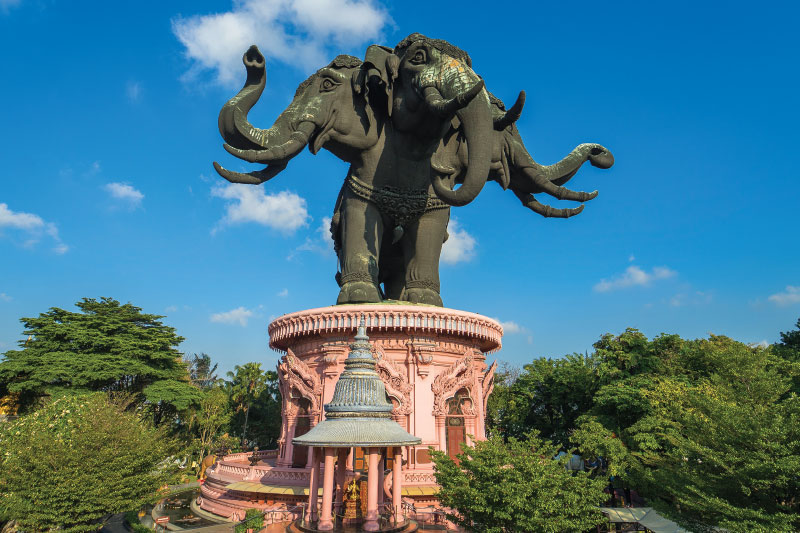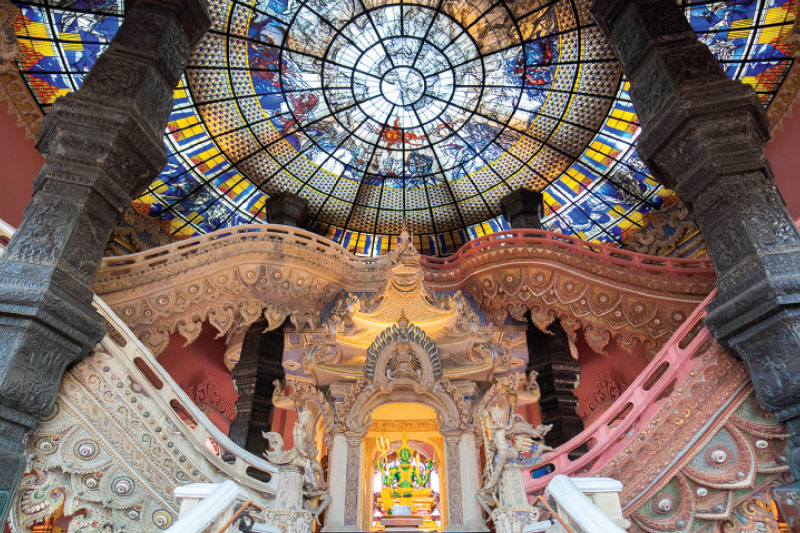
In the Belly of an Elephant
Samut Prakan, the neighbour of buzzing Bangkok, is your swift ticket to a fun and informative getaway
Words: Sarita Urupongsa
Samut Prakan has long been a go-to spot for relaxation among Bangkokians seeking the laid-back charm of their grandparents’ era. Take Bang Pu, where busy city dwellers find serenity in gorgeous seaside sunsets while feeding flocks of graceful gulls.
But guess what? Samut Prakan is no longer just a nostalgia trip. Bangkok’s next-door neighbour has evolved into a versatile destination, offering something for every explorer, from nature lovers to art and culture enthusiasts.
Behold Erawan Museum, a gleaming gem in Samut Prakan’s crown alongside the Ancient City. You’ll spot the copper armour of the giant elephant – claimed to be the largest hand-made sculpture in the world – from miles away. A marvel of craftmanship, the jumbo-shaped museum dominates the landscape just south of the capital. Step inside, and you’ll find a museum seamlessly woven into its colossal structure, showcasing precious art and wonders. This feat of engineering hides a celebration of Southeast Asian culture.
The three-headed elephant itself is not just eye candy. Erawan is the mythical creature that Indra, the Hindu guardian of heaven, rides to sprinkle goodness on our earthly realm. He is also the master of all elephants, revered and cherished.
If that isn’t exciting enough, there are three storeys of thrills waiting to be discovered insdie the museum.
The mastermind behind this captivating spectacle is Lek Viriyaphant, who had a vision of showcasing the splendour of Asian art and spirituality to the world. In our modern age, he believed it was essential not to lose sight of the roots and heritage that gave birth to each Asian country. So, what did he do? He dedicated his time, money, and impressive collection of rare and precious artifacts to creating Erawan Museum. The result is a fascinating journey through Asian civilisation for anyone curious about culture and religion.

Within the massive structure of the elephant, Erawan Museum unfolds like a captivating story, divided into three levels inspired by the Book of Bhumitha. Visitors are guided through the underworld, the human world, and the heavens.
Enter the ground floor to discover The Suvarnabhumi, where a collection of ancient artifacts and pottery takes centre stage. These relics paint a vivid picture of Southeast Asia’s glorious past, with porcelain as the key storyteller. The delicate art of ceramicware, passed down through generations, unveils the centuries-old sophistication of Southeast Asian communities. History gleams in the beauty of craftsmanship from bygone times.
Ascend to the second floor for The Human Earth, which forms the sturdy base supporting the majestic elephant. Here, East meets West in a harmonious blend of art. Feast your eyes on the masterpiece above – a stained-glass ceiling by German artist Jacob Schwarzkopf. Four colours symbolise the natural elements – yellow for land, blue for water, white for air, and red for fire – giving birth to the Earth in all its glory. The walls are lined with Phetchaburi stucco carvings of mythical creatures that capture the boundless imagination and creativity of humanity. The vibrant grace of Benjarong ceramicware crafted in Samut Songkhram’s Amphawa community and China adds more colour to this visual banquet.
As visitors enter Heaven, the stairs split in front of the majestic Phra Ket arch, guarded by the deity that protects earth and its oceans. The ceiling defies expectations, a breathtaking tapestry of chandeliers and recycled glass where smashed fragments shine anew as luminous art.
Supporting it are the Four Pillars, standing strong with the essence of four major religions united by universal truths and mercy. These octagonal pillars, covered in tin, narrate the moral tales of each faith.
Next comes the Cosmos on the third level, nestled inside the elephant’s body and accessed by elevator or spiral staircase. The walls are adorned with paintings of gods and goddesses, serenading your journey into the heavenly realm. The ceiling itself, painted in pastels, depicts the Universe, serving as a humbling reminder of our tiny existences in the vast abyss. Beneath it lies the Buddha’s footprint, surrounded by the mythical Mount Meru, creating a serene sanctuary for those seeking peace of mind.
After the journey to heaven, ground yourself with a leisurely stroll around the museum. The lush gardens, home to rare plants from all corners of Thailand, offer a glimpse into the rich diversity of forests and the flora and fauna celebrated in traditional Thai literature. The gardens are a living portrayal of the legendary Himavanta Forest, where rare plants, nymphs, and mythical creatures coexist harmoniously.
A trip to Erawan Museum is more than just a history lesson; it’s an immersive experience and also a peaceful retreat from the chaos of daily life. Only a short ride from Bangkok, Erawan offers a perfect half-day escape to appreciate the art and culture that shaped Southeast Asia.
Open daily 9am-6pm; www.erawanmuseum.com
